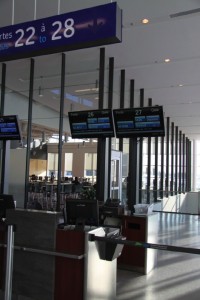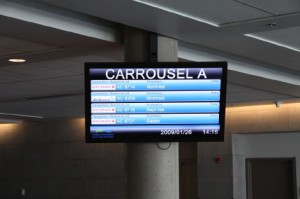Cisco Systems Re-Fit At Québec Airport
Gail Chiasson, North American Editor
Québec City’s Jean Lesage International Airport (Aéroport de Québec) is sporting about 80 new digital signs of various types and sizes.
They are part of a new $65 million airport renovation that includes a mix of unified communications, free Wi-Fi and other technologies, put in place with the help of Cisco Systems Inc., supplier of most of the network infrastructure, Hewlett-Packard Co., integrator on the project, and Com-Net Software for the screen system.
The project includes the installation of Cisco Unified Wireless IP phones for personnel to log into their specific airline profiles, which is handled by the firm’s Unified Communications Manager. Voice and data are carried over an 802.11n network, making Aeroport de Queebec the first airport in Canada to use 802.11n.
With the wireless features, airlines can make common use of check-in counters, allowing them to share facilities and speed up the process of checking in and managing passengers. As needed, the airline personnel can use a counter and control the digital screens, putting up their logo and other information.
“We now have 27 check-in counters and 12 gate counters,” says Marc-André Bédard, IT assistant manager at Aéroport de Québec, who handled the project. ”We have a small airport but must manage for peak hours. Without the new system, we would need about 45 counters and would need a lot larger space, which would be a lot more expensive.”
The common use stations are expected to present the most short-term return on investment.
The new system has three aspects: the common use counters; the mobile phone system; and the digital signage.
The network infrastructure and mobile technologies are similar to what is found in large enterprises, but the difference is the customized use of the applications that the airport is using on top of the infrastructure. The common-use environment meant that the airline staff had to learn not only how to to work the telephones, but also how to use the screens above the check-in counters controlled by the telephone or the computer. Additional digital screens are at the baggage carrousels, in various areas giving flight display information, in waiting areas and other areas.
“Screens above the counters or with flight information don’t carry advertising,” says Bédard. “People find it annoying or don’t remember it. But screens in other areas carry advertising.”
The system has been in place unofficially since June and, to date, there have been no failures with the network infrastucture. At the official launch earlier this month, Pascal Belanger, president and COO of the airport, said that airline expectations around reliability are high.
“Airlines used to have switches and routers going through the airport. Now, if something goes wrong, it’s our fault,” Belanger said.
Aéroport de Québec management is now considering adding a mobile IP-based application that gathers inspection data on runway surface conditions and relays it to a security control center for better communication among pilots and location tracking for trucks, snowplows and other equipment.



Follow DailyDOOH